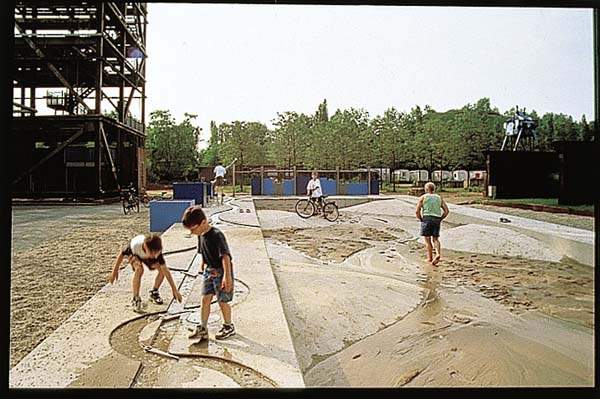This section summarizes my reflections on examining these two examples of post-industrial landscape reuse, with a particular eye to the environmental.
In both cases, the sites are left with remains of industry – in the case of the Landscape Park Duisburg-Nord, it is mostly the actual industrial buildings themselves; in Nine Mile Run, it is the slag.
Source: http://greenmuseum.org/c/ecovention/nmr3.html |
Slag! In the case of Nine Mile Run, housing was built atop the slag plateaus, no doubt yielding a price premium due to the views possible from that unnatural elevation! However, this does raise significant concerns regarding safety and the environment. Presumably, the topsoil on top of the slag, on top of which the houses are built, is stable -- but this is a rather unorthodox use for slag and could pose unknown dangers to the houses on top and the area below were the slag to become unstable. One of the top priorities in the Nine Mile Run rehabilitation project has been the revegetation of the slag slopes. Revegetation will certainly aid in the slopes' stabilization, and will additionally mask the slopes from the stream and greenway that runs alongside them. The Nine Mile Run stream and open space preserve winds its way throughout the slag heaps, and as long as the sides are unvegetated, the contrast between the natural and artificial landscape in this park is stark. |
| Not surprisingly, slag heaps are also present at Landscape Park Duisburg-Nord. But in this case, the landscape architect (Latz + Partner) allowed this new topography to revegetate naturally. Now, with time, the slag heaps blend into the landscape, growing wild with native vegetation. Perhaps they also go relatively unnoticed due to the startling prominence of the manmade industrial structures, and the slag heaps’ role in this environment is to seamlessly join the background of the park. | |
The Nature of Nature, Art, and Cultural Acceptance The Carnegie Mellon University Greenway Project articulates three elements that guide their approach to the Nine Mile Run site: 1) Reclamation Art: Using art to enact a paradigm shift from humans versus nature, humans above nature, to humans in harmony with nature. 2) Community Dialogue: Reconnecting people socially with their urban and natural environment; using brownfields as a means to engage public participation. 3) Ecosystem reclamation: Their concept of ecosystem reclamation is a interdisciplinary one, involving restoring the ecological functioning of a site so that the environmental quality – both visually/aesthetically and scientifically – is improved. These three elements define the CMU STUDIO for Creative Inquiry approach to the project and site, but I believe that they could just as easily describe the approach that the creators of Landscape Park Duisburg-Nord took in their concept and design. Despite the very different circumstances under which each case study was redeveloped, both sites owe their success as post-industrial landscapes to the above concepts. |
|
Source: Metropolis Magazine |
Community Involvement
|
| In Pittsburgh, slag heaps – albeit slag heaps that are being masked by topsoil and slope revegetation – are all that ties the site to its industrial past. But the area is not heavily visited by outsiders; it serves as a community resource alone, and what is there embodies what the citizens there want it to be. The state of Nine Mile Run today, as a restored stream, park, and natural system, is in large part the doing of local residents. What is important to them is this ecological restoration, the reclamation of a once and future parkland in their neighborhood. | |

